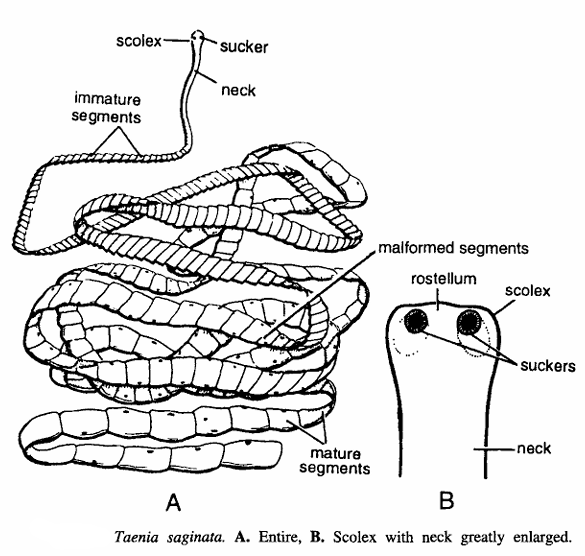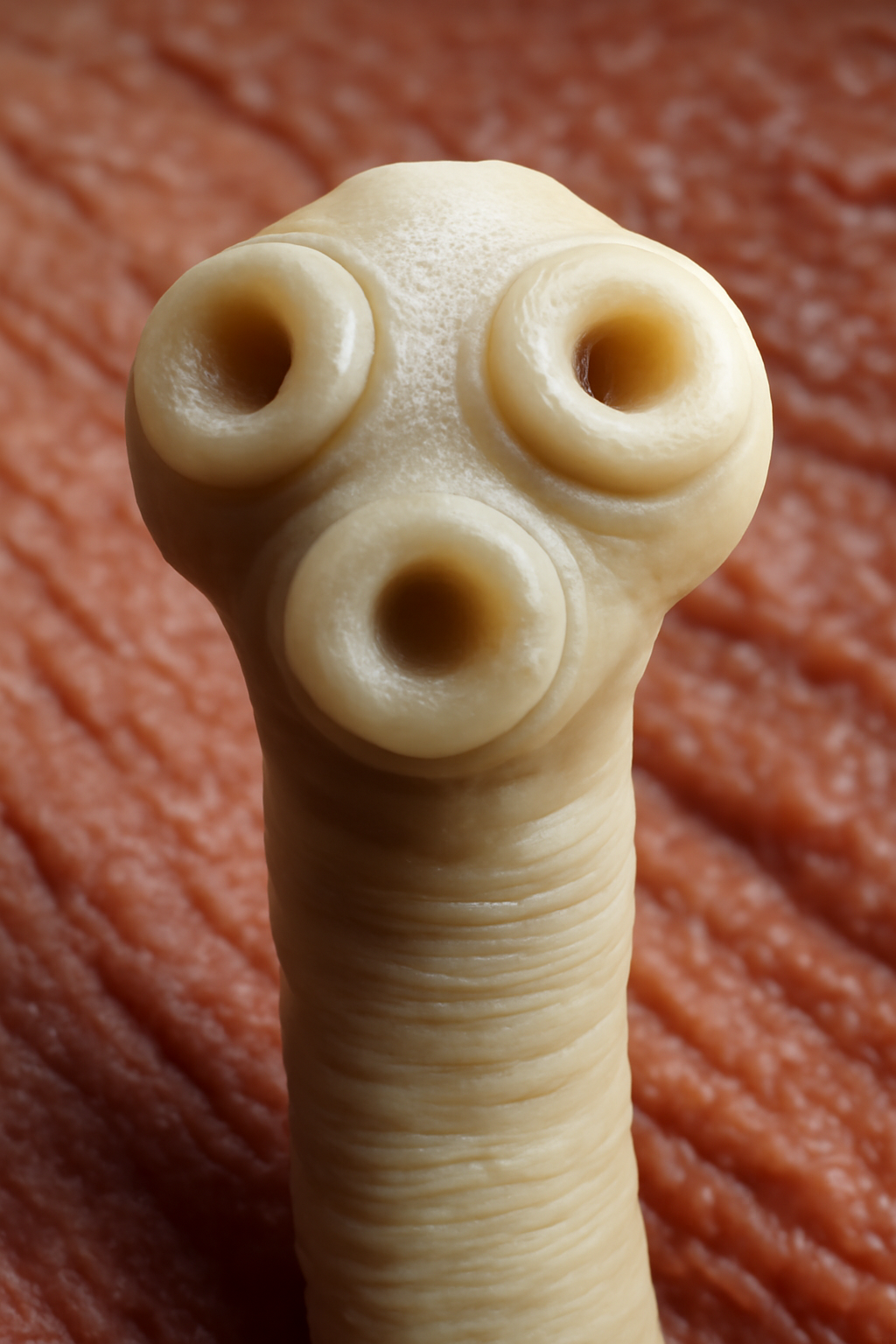Introduction
Taenia saginata, commonly known as the beef tapeworm, is a parasitic cestode of major medical and veterinary importance. Belonging to the phylum Platyhelminthes and class Cestoda, it infects humans as the definitive host and cattle as the intermediate host. Humans acquire taeniasis by consuming raw or undercooked beef containing the infectious larval stage, called cysticerci. The adult tapeworm resides in the small intestine, producing symptoms ranging from mild digestive discomfort to the passage of motile proglottids. This parasite has a global presence, especially in regions where cattle farming and meat consumption overlap with inadequate sanitation and food safety practices.
Classification of Taenia saginata (Beef Tapeworm)
| Classification Level | Name | Characteristic |
|---|---|---|
| Kingdom | Animalia | Multicellular eukaryotic organisms |
| Phylum | Platyhelminthes | Flatworms with dorso-ventrally flattened, segmented bodies |
| Class | Cestoda | Parasitic tapeworms lacking a digestive system |
| Order | Cyclophyllidea | Tapeworms with a scolex having four suckers |
| Family | Taeniidae | Tapeworms with complex lifecycles involving vertebrate hosts |
| Genus | Taenia | Cestodes with scolex armed with suckers |
| Species | saginata | Beef tapeworm infecting humans and cattle |

Habit and Habitat
Taenia saginata adults inhabit the small intestine of humans, where they attach to the mucosa using a scolex with four suckers. The parasite absorbs predigested nutrients through its tegument. The intermediate host is the cow, which ingests eggs or proglottids shed by infected humans. Oncospheres hatch in the cow’s intestine, penetrate the intestinal wall, and form cysticerci—infective larval cysts—in muscle tissues. Humans ingest cysticerci by consuming raw or undercooked beef, completing the lifecycle. The parasite’s survival depends on overlapping human-cattle ecosystems with shared access to contaminated areas and food.
Geographical Distribution
Taenia saginata is cosmopolitan but more prevalent in Africa, Asia, Latin America, Europe, and parts of the Middle East where cattle farming is common. It thrives especially in regions with poor sanitation and limited meat inspection protocols. The widespread nature of cattle farming makes it a persistent public health concern worldwide. While less common in developed regions with strict sanitary control, cases do occur due to increased migration and changing dietary preferences.
General Characteristics
- Commonly called as Beef tape-worm.
- Preserved specimen is whitish in colour and is divided into scolex, neck and segments or strobila.
- Strobila is dorsoventrally flattened. Scolex contains 4 suckers. Rostellum and hooks are absent. Segments are about 1000 in number measuring about 4 to 6 meters.
- Segments are of 4 kinds-immature, mature, gravid and malformed.
- Life history includes man as definitive host and buffalo as intermediate host.
- Man acquires infection by eating raw and inadequately cooked beef mutton containing cysticercous larvae.
- Buffalo gets infection while grazing on contaminated grasses polluted by human faeces having eggs of T. saginata.
- Body Morphology: The adult beef tapeworm is one of the longest human parasites, ranging from 4 to 12 meters in length, though specimens up to 25 meters have been reported. It has a dorsoventrally flattened, segmented ribbon-like body.
- Scolex: The anterior end features an unarmed scolex with four muscular suckers that anchor the tapeworm to the intestinal wall; notably, it lacks hooks unlike Taenia solium.
- Strobila: Comprises 1000-2000 proglottids (segments), each containing male and female reproductive organs. Mature gravid proglottids break off to leave the host in feces or migrate independently.
- Tegument: The surface has hair-like microtriches enhancing nutrient absorption from the host.
- Digestive System: Absent; nutrient absorption occurs across the tegument.
- Reproductive System: Hermaphroditic with high egg production, ensuring persistence and transmission.

Special Features
- Unarmed Scolex: The lack of hooks on the scolex differentiates Taenia saginata from Taenia solium, aiding in identification.
- Long Lifespan: Adults may survive 25 years or more, potentially producing millions of eggs during their lifespan.
- Motile Proglottids: Gravid proglottids are independently motile, which aids in dispersing eggs in the environment without requiring defecation.
- Lifecycle Dependence: Requires human definitive host and bovine intermediate host, involving fecal contamination and cysticercosis of cattle muscles.
- Clinical Manifestations: Infection in humans is often asymptomatic or mild but can involve gastrointestinal discomfort, diarrhea, or anal irritation.
Identification
Identification is mainly morphological and clinical:
- Scolex Morphology: Four suckers and absence of rostellic hooks distinguish it from pork tapeworm.
- Proglottids: Number of uterine branches per side is higher (15-30), compared to T. solium.
- Eggs: Microscopic eggs are indistinguishable from T. solium but can be differentiated by host history and clinical testing.
- Molecular Diagnosis: PCR and serology support definitive diagnosis.

Lifecycle Overview
- Humans harbor adult tapeworms in the intestine, shedding eggs or proglottids in feces.
- Cattle ingest contaminated vegetation containing eggs.
- Oncospheres hatch in cattle intestine and lodge in muscles as cysticerci.
- Humans consume undercooked beef with cysticerci.
- Cysticerci mature into adult tapeworms in humans over about 2 months.
Health and Economic Impacts
While Taenia saginata infection rarely causes severe disease, it can cause discomfort and nutritional deficits. Economic losses relate to meat condemnation and reduced cattle productivity when infected. Control relies on proper meat inspection, sanitation, and cooking meat thoroughly.
Conclusion
Taenia saginata remains a globally significant parasitic cestode mainly affecting humans and cattle. Its unique biological features, complex lifecycle, and potential for long-term infection underscore the importance of public health measures and veterinary controls to limit its spread.
References
- https://www.sciencedirect.com/topics/agricultural-and-biological-sciences/taenia-saginata
- https://en.wikipedia.org/wiki/Taenia_saginata
- https://www.cdc.gov/dpdx/taeniasis/index.html
- https://www.msdmanuals.com/professional/infectious-diseases/cestodes-tapeworms/taenia-saginata-beef-tapeworm-infection
- https://www.ebsco.com/research-starters/zoology/beef-tapeworm
- https://pmc.ncbi.nlm.nih.gov/articles/PMC12262091/
- https://www.ncbi.nlm.nih.gov/books/NBK537154/
- https://www.sciencedirect.com/topics/immunology-and-microbiology/taenia-saginata
- https://www.who.int/news-room/fact-sheets/detail/taeniasis-cysticercosis
